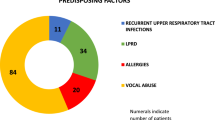Abstract
To establish the prevalence of etiological factors for dysphonia in elderly individuals in rural India. Hundred adults aged ≥ 65 years, who presented with dysphonia for ≥ 4 weeks and underwent detailed clinical evaluation including videolaryngoscopic assessment and other appropriate investigations/evaluation, were included in a retrospective cohort clinical study. Patients were classified into eight groups for further descriptive statistical analysis based on standard diagnostic criteria/guidelines i.e. benign vocal cord lesions, inflammatory disorders of the larynx, laryngeal and hypopharyngeal neoplasms, isolated vocal cord palsy/paresis, presbylaryngis, central neurological disorders affecting laryngeal function, impaired pulmonary function and non specific dysphonia. Mean age was 70.73 ± 4.29 years. 58% were aged between 65 and 69 years. Overall, the common causes for dysphonia were laryngopharyngeal reflux disease (23%), carcinoma larynx (12%) and presbylaryngis (8%). Inflammatory disorders of the larynx, benign vocal cord lesions and laryngeal/hypopharyngeal malignancies were the commonest causes for dysphonia in individuals aged between 65 and 74 years. Presbylaryngis and systemic causes were the commonest among individuals aged 75–89 years. 63 males and 37 females met the inclusion criteria. The most common cause for dysphonia among females was laryngopharyngeal reflux disease (17%), followed by vocal palsy (5%) and spasmodic dysphonia (4%). Carcinoma larynx (12%) was the most common cause for dysphonia among males, followed by laryngopharyngeal reflux (6%) and presbylaryngis (6%). Geriatric dysphonia is an often overlooked symptom of greater underlying disease as evidenced in this study. With its impact on the quality of life in this age group and life expectancy in the rural population, dysphonia requires early detection, prompt evaluation and appropriate management.



Similar content being viewed by others
References
Ingle GK, Nath A (2008) Geriatric health in India: concerns and Solutions. Indian J Community Med Off Pub Indian Assoc Prev Soc Med 33(4):214–218
Sashindran VK (2018) Geriatric care: need of the hour. Med J Armed Forces India 74(1):3–4
Roy N, Kim J, Corey M et al (2016) Voice disorders in the elderly: a national database study. Laryngoscope 126(2):421–428
Roy N, Stemple J, Merrill RM et al (2007) Epidemiology of voice disorders in the elderly: preliminary findings. Laryngoscope 117(4):628–633
Kandhan T, Olgun L, Gultekin G (2003) Causes of dysphonia in patients above 60 years of age. Kulak burun boğaz ihtisas dergisi: KBB = Journal of Ear, Nose, and Throat 11(5):139–143
Pernambuco LD, Espelt A, Balata PM et al (2014) Prevalence of voice disorders in the elderly: a systematic review of population-based studies. Eur Arch Otorhinolaryngol 272:2601–2609
Cohen SM, Kim J, Roy N et al (2012) Prevalence and causes of dysphonia in a large treatment-seeking population. Laryngoscope 122(2):343–348
Basken JN, Connor NP, Ciucci MR (2012) Effect of aging on ultrasonic vocalizations and laryngeal sensorimotor neurons in rats. Experimental Brain Research. Experimentelle Hirnforschung. Experimentation Cerebrale 219(3):351–361
Woo P, Casper J, Colton R (1992) Dysphonia in the aging: physiology versus disease. Laryngoscope 102(2):139–144
Patel N (2006) Phonation-dysphonia: the voice of change-voice change is common with advancing age and its causes are frequently multifactorial. It can be disabling and/or an indication of serious disease. Geriatr Med Coventry 36(11):63–66
Lundy DS, Silva C, Casiano RR et al (1998) Cause of hoarseness in elderly patients. Otolaryngol Head Neck Surg 118(4):481–485
Vaca M, Mora E, Cobeta I (2015) The aging voice: influence of respiratory and laryngeal changes. Otolaryngol Head Neck Surg 153(3):409–413
Ciyiltepe M, Senkal OA (2017) The ageing voice and voice therapy in geriatrics. Aging Clin Exp Res 29:403–410
Morrison MD, Gore-Hickman P (1986) Voice disorders in the elderly. J Otolaryngol 15(4):231–234
Gregory ND, Chandran S, Lurie D et al (2012) Voice disorders in the elderly. J Voice 26(2):254–258
Karakaya NE, Akbulut S, Altıntaş H et al (2015) The reflux finding score: reliability and correlation to the reflux symptom index. J Acad Res Med 5(2):68–74
Belafsky PC, Postma GN, Koufman JA (2001) The validity and reliability of the reflux finding score (RFS). Laryngoscope 111(8):1313–1317
Watson MG (2011) Review article: laryngopharyngeal reflux-the ear, nose and throat patient. Aliment Pharmacol Ther 33(1):53–57
Pontes P, Brasolotto A, Behlau M (2005) Glottic characteristics and voice complaint in the elderly. J Voice 19(1):84–94
Banjara H, Mungutwar V, Singh D et al (2012) Demographic and videostroboscopic assessment of vocal pathologies. Indian J Otolaryngol Head Neck Surg 64(2):150–157
Author information
Authors and Affiliations
Corresponding author
Ethics declarations
Conflict of interest
All authors declare that they have no conflict of interest.
Ethical Approval
All procedures performed in studies involving human participants were in accordance with the ethical standards of the institutional research committee and with the 1964 Helsinki declaration and its later amendments and comparable ethical standards.
Rights and permissions
About this article
Cite this article
Mathew, A.S., Shilpa, H. Geriatric Dysphonia: Etiological Analysis in a Rural Hospital in India. Indian J Otolaryngol Head Neck Surg 71, 218–224 (2019). https://doi.org/10.1007/s12070-018-1507-0
Received:
Accepted:
Published:
Issue Date:
DOI: https://doi.org/10.1007/s12070-018-1507-0




